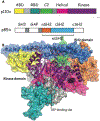Diacylglycerol kinases: Relationship to other lipid kinases
- PMID: 30348515
- PMCID: PMC6347529
- DOI: 10.1016/j.jbior.2018.09.014
Diacylglycerol kinases: Relationship to other lipid kinases
Abstract
Lipid kinases regulate a wide variety of cellular functions and have emerged as one the most promising targets for drug design. Diacylglycerol kinases (DGKs) are a family of enzymes that catalyze the ATP-dependent phosphorylation of diacylglycerol (DAG) to phosphatidic acid (PtdOH). Despite the critical role in lipid biosynthesis, both DAG and PtdOH have been shown as bioactive lipids mediating a number of signaling pathways. Although there is increasing recognition of their role in signaling systems, our understanding of the key enzyme which regulate the balance of these two lipid messages remain limited. Solved structures provide a wealth of information for understanding the function and regulation of these enzymes. Solving the structures of mammalian DGKs by traditional NMR and X-ray crystallography approaches have been challenging and so far, there are still no three-dimensional structures of these DGKs. Despite this, some insights may be gained by examining the similarities and differences between prokaryotic DGKs and other mammalian lipid kinases. This review focuses on summarizing and comparing the structure of prokaryotic and mammalian DGKs as well as two other lipid kinases: sphingosine kinase and phosphatidylinositol-3-kinase. How these known lipid kinases structures relate to mammalian DGKs will also be discussed.
Copyright © 2018 Elsevier Ltd. All rights reserved.
Conflict of interest statement
Conflict of interest
There are no conflicts of interest associated with the information in this review.
Figures


Similar articles
-
Elusive structure of mammalian DGKs.Adv Biol Regul. 2022 Jan;83:100847. doi: 10.1016/j.jbior.2021.100847. Epub 2021 Dec 2. Adv Biol Regul. 2022. PMID: 34922895 Free PMC article. Review.
-
Diacylglycerol, phosphatidic acid, and their metabolic enzymes in synaptic vesicle recycling.Adv Biol Regul. 2015 Jan;57:147-52. doi: 10.1016/j.jbior.2014.09.010. Epub 2014 Sep 28. Adv Biol Regul. 2015. PMID: 25446883 Free PMC article. Review.
-
Regulation and roles of neuronal diacylglycerol kinases: a lipid perspective.Crit Rev Biochem Mol Biol. 2011 Oct;46(5):353-64. doi: 10.3109/10409238.2011.577761. Epub 2011 May 4. Crit Rev Biochem Mol Biol. 2011. PMID: 21539478 Review.
-
Diacylglycerol kinase θ: regulation and stability.Adv Biol Regul. 2013 Jan;53(1):118-26. doi: 10.1016/j.jbior.2012.09.007. Epub 2012 Sep 20. Adv Biol Regul. 2013. PMID: 23266086 Free PMC article.
-
Phosphorylation of DGK.Adv Biol Regul. 2023 May;88:100941. doi: 10.1016/j.jbior.2022.100941. Epub 2022 Dec 7. Adv Biol Regul. 2023. PMID: 36508895 Review.
Cited by
-
Cec4-Derived Peptide Inhibits Planktonic and Biofilm-Associated Methicillin Resistant Staphylococcus epidermidis.Microbiol Spectr. 2022 Dec 21;10(6):e0240922. doi: 10.1128/spectrum.02409-22. Epub 2022 Dec 1. Microbiol Spectr. 2022. PMID: 36453944 Free PMC article.
-
Current advancements and future perspectives of long noncoding RNAs in lipid metabolism and signaling.J Adv Res. 2023 Jun;48:105-123. doi: 10.1016/j.jare.2022.08.007. Epub 2022 Aug 13. J Adv Res. 2023. PMID: 35973552 Free PMC article. Review.
-
Structural anatomy of Protein Kinase C C1 domain interactions with diacylglycerol and other agonists.Nat Commun. 2022 May 16;13(1):2695. doi: 10.1038/s41467-022-30389-2. Nat Commun. 2022. PMID: 35577811 Free PMC article.
-
Elusive structure of mammalian DGKs.Adv Biol Regul. 2022 Jan;83:100847. doi: 10.1016/j.jbior.2021.100847. Epub 2021 Dec 2. Adv Biol Regul. 2022. PMID: 34922895 Free PMC article. Review.
-
Novel putative causal mutations associated with fat traits in Nellore cattle uncovered by eQTLs located in open chromatin regions.Sci Rep. 2024 May 2;14(1):10094. doi: 10.1038/s41598-024-60703-5. Sci Rep. 2024. PMID: 38698200 Free PMC article.
References
-
- Adams DR, Pyne S, and Pyne NJ. 2016. Sphingosine Kinases: Emerging Structure-Function Insights. Trends Biochem Sci 41:395–409. - PubMed
-
- Baldanzi G 2014. Inhibition of diacylglycerol kinases as a physiological way to promote diacylglycerol signaling. Adv Biol Regul 55:39–49. - PubMed
-
- Baldanzi G, Cutrupi S, Chianale F, Gnocchi V, Rainero E, Porporato P, Filigheddu N, van Blitterswijk WJ, Parolini O, Bussolino F, Sinigaglia F, and Graziani A. 2008. Diacylglycerol kinase-alpha phosphorylation by Src on Y335 is required for activation, membrane recruitment and Hgf-induced cell motility. Oncogene 27:942–956. - PubMed
-
- Braccini L, Ciraolo E, Campa CC, Perino A, Longo DL, Tibolla G, Pregnolato M, Cao YY, Tassone B, Damilano F, Laffargue M, Calautti E, Falasca M, Norata GD, Backer JM, and Hirsch E. 2015. PI3K-C2 gamma is a Rab5 effector selectively controlling endosomal Akt2 activation downstream of insulin signalling. Nature Communications 6. - PMC - PubMed
Publication types
MeSH terms
Substances
Grants and funding
LinkOut - more resources
Full Text Sources
Other Literature Sources

